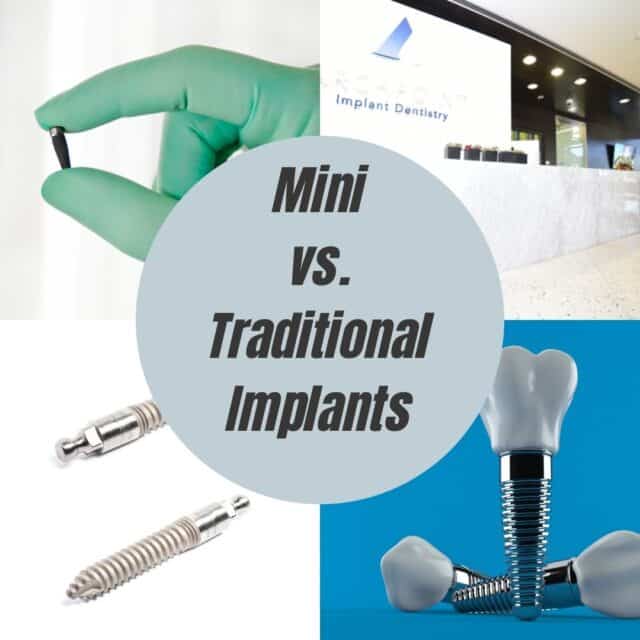If you’ve done any research into dental implant treatment in DFW, chances are you’ve run across ads for mini dental implants. What are mini implants? Why are they so cheap? And most importantly, what can you use them for?
Understanding the difference between mini and traditional implant designs can help you know whether these one-of-a-kind treatments are right for your situation.
Description of Mini Dental Implants
Mini dental implants are any dental implant design that’s less than 3mm wide. That’s about the height of two pennies stacked on top of one another. It’s about half of the size or less of a full, traditional dental implant.
Since mini dental implants are so small, it’s not possible to make them hollow at the top like a full dental implant design. Since it’s not hollow, dentists cannot screw an abutment into it. Abutments are the attachments that go on top of a regular implant, which support the crown or bridge on top of it.
The solid design of a mini implant (without an abutment) means that once it’s installed, it will stick up out above the gumline so that something can attach to it. It’s one solid piece and no alternative abutment designs are used.
Cost of Mini Dental Implants
The price of mini dental implants in Dallas and Fort Worth is significantly cheaper than full, traditional dental implants. So, if you see advertised implant treatments that seem extremely affordable or too good to be true, it’s probably because the dentist is using mini implants.
Just remember that you get what you pay for. The low cost of mini implants (DFW) usually also means you’re going to need to pay to replace them with something else later on. It’s best to look at the investment as a temporary one, so consider your overall return on investment when comparing mini and traditional implant costs.
Disadvantages of Mini Implants
The smaller design of mini dental implants makes them weaker and more prone to breakage than a full implant. Since mini dental implants are one solid design rather than hollow with an abutment, you’re more likely to see complications, such as the implant snapping at the gumline. Unfortunately, there’s no way to repair it; the entire mini implant would need to be replaced. Whereas with a traditional implant we would just unscrew the broken abutment and install a new one. With mini implants, you have to remove them and start all over.
Additionally, you usually can’t install mini implants in the upper jaw. They need very dense bone to support them, and your lower jaw (mandible) is the densest. They typically aren’t used very often for upper tooth replacement.
And finally, you tend to need more mini implants to support a full arch restoration than you would if you were using traditional implants. For example, you can support a complete overdenture with just two implants in your lower jaw. But if you’re using mini dental implants, you need at least four in your lower jaw and six in your upper.
What Does the Research Say?
The information out there on mini dental implants is fairly confusing. Research tends to show that mini dental implants are about six times more likely to fail in the upper jaw than the lower jaw. And we really don’t know what the long-term survival rate is if there is one at all. One researcher who was a board-certified prosthodontist even shared that there isn’t any evidence whatsoever of long-term survival for mini implant designs.
In most scenarios, mini dental implants are best used for temporary purposes, as opposed to long-term full mouth reconstruction.
Uses for Mini Implants
Given the research, the ideal use for mini dental implants is temporary at best. Such as securing a removable overdenture. You can sometimes find dental experts who use mini implants to stabilize prosthetics while patients are waiting to get traditional implants in the future.
Believe it or not, orthodontists frequently use mini dental implants alongside braces treatments. Particularly when they need an anchor to help reposition and align molars at the back of your mouth. The mini implant is installed, a bracket is attached, the adjacent tooth is moved, and then the implant is taken out. It offers just enough traction for temporary purposes to make it through the short-term orthodontic treatment.
Mini vs. Traditional Dental Implants
Full-size dental implants are usually best for long-term purposes. They can also be placed in both the lower and upper jaw, respectively. They offer the best return on investment whether you’re replacing one tooth or all of them.
On the other hand, mini dental implants offer a fast, temporary, cheap alternative to dental implants. But they’re usually only good for short-term purposes and in the lower jaw. Plus, there’s a higher risk they can break and need to be replaced.
Both types of implants work for replacing missing teeth, but you have fewer options available with mini dental implant designs. Such as securing an overdenture but not replacing a top front tooth or molar. Whereas full-size implants can be used for single, multiple, or full-arch rejuvenation.
Which One is Right For Me?
Working with a DFW dental implant specialist can help you understand which type of implant is best for your specific situation. If you’re looking for something that’s affordable and temporary, then yes, maybe mini implants are best. But if your goal is long-term smile restoration, a full traditional implant will be the best investment. Plus, you can usually finance your treatment into affordable monthly payments so that the process is still budget-friendly.
As you’re researching your dental implant choices, just keep the big goal in mind. Are you looking for something temporary and cheaper that will need to eventually be replaced or something more long-term?
Reserve a Consultation Today
Contact ARCHPOINT in Dallas or Fort Worth to reserve a one-on-one implant consultation with one of our leading DFW specialists. We’ll be happy to discuss your tooth replacement options with you!








